
My visit to Philcox had been successful and the old flange had been successfully removed. Philcox had suggested that the triangular flange should have been welded on the other side of the flange as was consistent with traditional methods of exhaust manufacture. They cut a new flange fro
 m stainless steel and ensured that the hole in the centre of the flange allowed the pipework to fit snugly inside. They used a plasma torch to cut around the gasket which would be cleaned up after the position of the flange had been ascertained and tacked, re-checked and then finally welded in position. I was very pleased with the job that they had done so far and it was obvious that the work they had done looked no longer like my own and more like that done by a professional company, something the previous company that worked on this item failed to realize. When you pay for a professional job, it should be just that, not something that you could have done at home with a MiG welder and some stainless steel MiG wire.
m stainless steel and ensured that the hole in the centre of the flange allowed the pipework to fit snugly inside. They used a plasma torch to cut around the gasket which would be cleaned up after the position of the flange had been ascertained and tacked, re-checked and then finally welded in position. I was very pleased with the job that they had done so far and it was obvious that the work they had done looked no longer like my own and more like that done by a professional company, something the previous company that worked on this item failed to realize. When you pay for a professional job, it should be just that, not something that you could have done at home with a MiG welder and some stainless steel MiG wire.I would need to mark the flange position with a level and ensure the turbo bracket was in the correct position. Once this had been established, I would be able to return the two parts to have them tacked up.
With the two parts marked up with a pencil it was going to be a couple of days til the two parts could be tacked together.
I had been ordering some oil line parts for the oil feed for the turbo and received some of the parts only to find that they where the wrong size. I had ordered a 1/8bsp to 4-N adapter thinking that the 4-N was the size of the Goodridge Ford Cosworth oil line. Unfortunately this was not only to Small but had the curve on the thread top convex instead of concave. I learnt something today all bsp fittings have concave tops to the threads. I ordered the new adapter the 1/8bsp to 1/4bsp adapter and hoped this would be the correct one as these threaded fitting are very difficult to match up.






















No comments:
Post a Comment